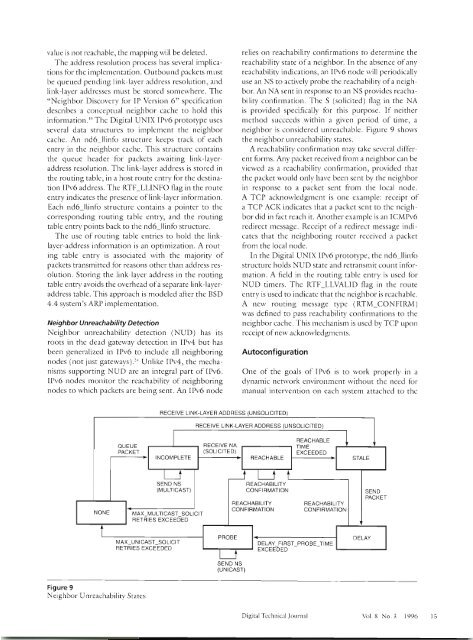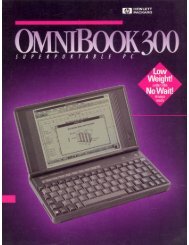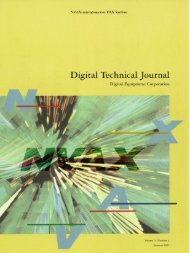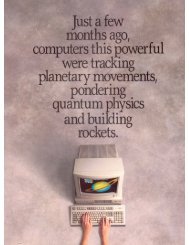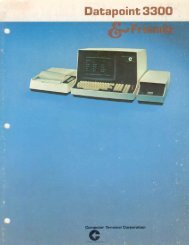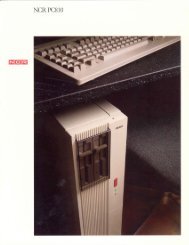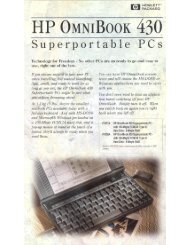Create successful ePaper yourself
Turn your PDF publications into a flip-book with our unique Google optimized e-Paper software.
\lalue is not reachable, tlie mapping \\lill be deleted.7'he address resolution process has several implicationsfor the implementation. Outbound packets mustbe quelled pending link-layer address resolution, andlink-layer addresses must be stored sonie~vliere. Tlie"Neighbor Disco\lery for IP Version 6" specificationdescribes a conceptual neighbor cache to hold thisinformation."' The Digital UNIS Ihr6 prototype usesseveral data structures to implement the neighborcache. An nd6-llinfo structure keeps track of eachentry in the neighbor cache. This structure containsthe queue header for packets awaiting link-layeraddressresolution. The link-layer address is stored inthe routing table, in a host route entry for the destinationIhl6 address. The RTF-LLINFO flag in the routeentry indicates the presence of link-layer information.Each nd6-llinfo structure contains a pointer to thecorresponding routing table entry, and tlie routingtable entry points baclc to the nd6-llinfo structure.The use of routing-table entries to hold the linlclayer-addressinformation is an optimization. A routingtable entry is associated with thc majority ofpackets transmitted for reasons other than address resolution.Storing the linlc-layer address in the routingtable entry avoids the overhead of a separate link-layeraddresstable. This approach is modeled after the BSD4.4 system's AN' implenientation.Neighbor Unreachability DetectionNeighbor unreachability detection (NUD) has itsroots in the dead gateway detection in Ih14 but hasbeen generalized in IPv6 to include all neighboringnodes (not just gatc~ays).~~ Unlike 11\14, the rnechanismssupporting NUD are an integral part of IPv6.11'116 nodes monitor the reachability of neighboringnodes to which packets are being sent, An IPv6 noderelies on reachability confirmations to determine tliereachability state of a neigllbor. In the absence of anyreachability indications, an IPv6 node n~ill periodicallyuse an NS to acti\iely probe the reachability ofa neighbor.Ai NA sent in response to an NS provides reachabilityconfirmation. The S (solicited) flag in the NAis provided specifically for this purpose. If neithermethod succeeds within a given period of time, aneighbor is considered unreachable. Figure 9 sho\vsthe neighbor unreacl~abilit)~ states.A reachability confirlnation may take several differentforms. Any packet received from a neighbor can beviewed as a reachability confrrnation, provided thatthe pacltet c\lould only have been sent by the neighborin responsc to a paclcet sent from the local node.A TCP aclu~o\\lledgment is one esample: receipt ofa TCP ACI< indicates that a packet sent to the neighbordid in fact reach it. Another exa~nplc is an ICIMP\I~redirect message. Rcccipt of a redirect message indicatesthat the neigl~boring router received a packetfrom the local node.In tlie Digital UNIX IPv6 prototype, the nd6pllinfostructure holds NUD state and retrans~nit count informatio~?.A field in the routing table entry is used forNUD timers. Tlie RTF-LLVALID flag in the routeentry is used to indicate that the neighbor is reachable.A nc\v routing message type (RTM-CONFIRM)\\.as defined to pass reachability confirmations to theneighbor cache. This mechanism is used by TCP uponreceipt of new ackno~vledgments.AutoconfigurationOne of the goals of IPv6 is to \vork properl!~ in adynamic nct\\lork e~nrironrncnt without the need formanual intervention on each system attached to thcIQUEUEPACKET +RECEIVE LINK-LAYER ADDRESS (UNSOLICITED)RECEIVE LINK-LAYER ADDRESS (UNSOLICITED)I I IREACHABLERECEIVE NA(SOLICITED)EXCEEDEDINCOMPLETE REACHABLE STALE-NONESEND NS-(MULTICAST)REACHABILITYMAX-MULTICAST-SOLICITRETRIES EXCEEDEDREACHABILITYCONFIRMATIONREACHABILITYCONFIRMATIONCONFIRMATIONPACKETt PROBE +MAX-UNICAST-SOLICITRETRIES EXCEEDED-SEND NS(UNICAST)I 4 EXCEEDEDDELAY-FIRST-PROBE-TIMEDELAYFigure 9Neighbor Unreachability StatesDigital Tcchnic~l Journal \ful.SNo.3 1996 15


